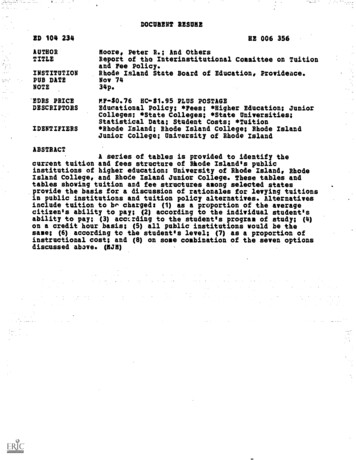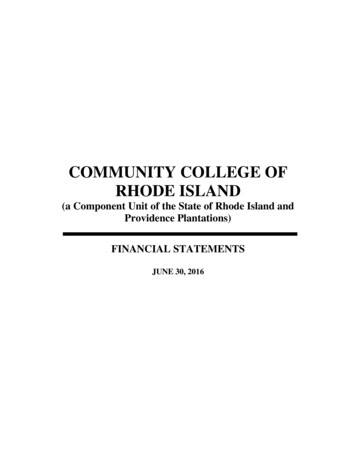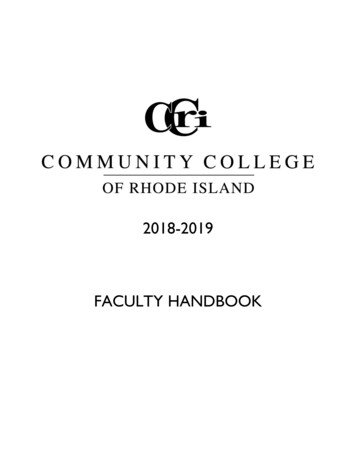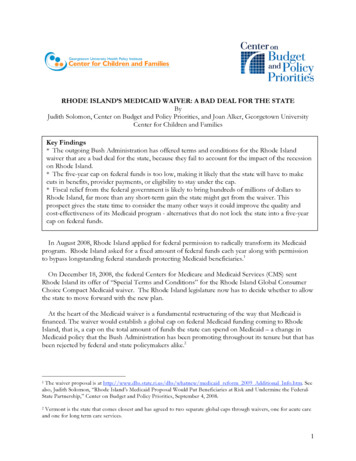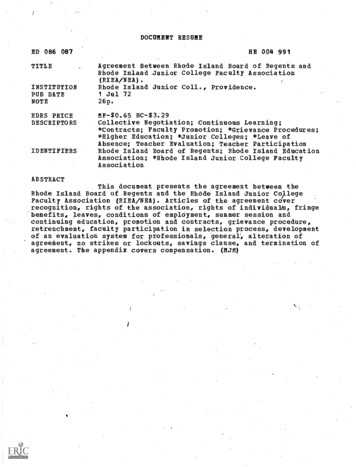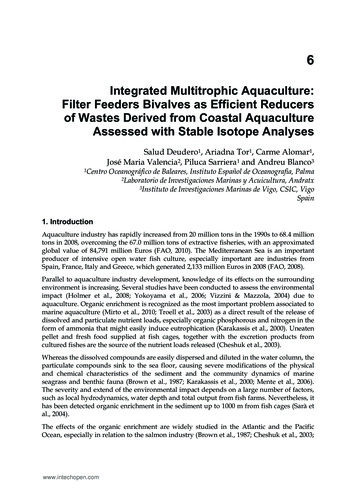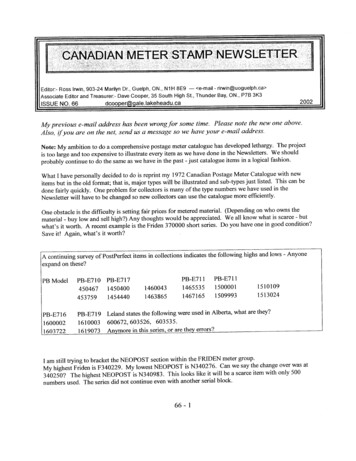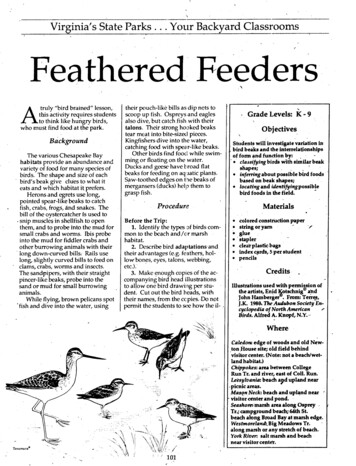
Transcription
Virginia's StateParks. Your BackyardClassroomsFeatheredtruly "bird brained" lesson,this activity requiresstudentsto think like hungry birds,who must find food at the park.BackgroundThe various ChesapeakeBayhabitats provide an abundance andvariety of food for many speciesofbirds, The shape and size of each' bird's beak give clu'esto what iteats and which habitat it prefers.Heronsand egretsuselong,pointed spear-likebeaksto catchfish, crabs, frogs, and snakes, Thebill of the oystercatcher is used to. snip muscles in shellfish to openthem, and to probe mto the mud forsmall . rabs and worms. Ibis probeinto the mud for fiddlercrabs andFeederstheir pouch-like bills as dip nets toscoopup fish. Ospreysand eaglestalons. Their strongho kedbeaksteat meat into bite-sized pieces.Kingfishers dive into the water,catching food with spear-like beaks.Other birdsfind food whileswim-ming or floating on the water.Ducks and geesehave broad flatbeaks for feeding on aq vatic plants.Saw-toothed edgeson t hebeaks ofmergansersducks!help them tograsp fish.Studentswill investigatevariation inbird beiks andtheinterrelabonshipsof form and function by: classifyingbirdswith similarbeakshapes; irsferriagaboutpossiblebird foodsbased on beak shapes; locatingand identif'yiogpossibleMaterialsBefore the Trip:1. Identify the types of birds common to the beach and/ormarshhabitat.clams, crabs, worms and insects.etc.!. coloredconstiuctionpaper string or yarnglue ' stapler clea'rplastic bags indexcards,5 perstudent pencilsCredits3. Make enough copies of the ac-companyingbird headillustrationssand or mu'd for sma11burrowingto allow one bird drawing per stu-animals.dent. Cut out the bird heads, withWhile flying, brown pelicansspot'fish and dive into the water,usingK- 9ObjectivesProcedure2. Describe bird adaptations andtheir advantages e.g. feathers, hollow bones, eyes, talons, webbing,pincer-likebeaks,probe into theLevels:bird foods in the field.other burrowing animals with theirlong down-curved bills: Rails uselong, slightly curved bills to feed onThe sandpipers, with their straight Gradealso dive, but catch fish with theirtheir names, from the ccpies.-Do notpermit the studentsto em how the il-Illustrations used with permission oftheartists,EnidIgotschniga d'JohnHamberger. From:Tenes,.J.K. 198L TheAudscboeSocietyEncyclopediaof North AmericanBirds.Alfred A. Knopf, N.Y.WhereCaledomedgeof woodsandold Newton House site; old field behindvisitor center. Note: not a beach/wetland habitat.!Chippokes:areabetweenCoil'egeRun Tr. and river, eastof ColL Run.Leesylvania:beachayduplandnear-picnic areas.Mason¹ck: beachanduplandnearvisitor centerand each;64thSt.beachalongBroadBayat marshedge.Westmoreland:.BigMeadowsTr.along arsh or anystretchof beach.TeramuraX,i ''iII /'.A!I! .' - 8101York River. salt marsh and beachnear visitor center.
Featheredlustrations are grouped or the groupconstruction measure and cut a piece of yarnlong enough to go over their ownheads comfortably; attach'the yarn to the top c'ornersof theconstructionpaper.5. Talk about adaptation, focus-ing on bird beakshapes.Encouragethe class to make some inferencesabout what a beak shape can tellabout a bird i.e. type of food itfeeds on!, and what ways birds canbe classified into groups i.e. beakshapes!.each studentstudiestheshape of the beak on his or her birdpicture, direct the students to formgroups of similar beaks. Discusswith each group their logic in forming the group.7. Each group makes inferencesas to which4. Lead the students to a beach,marsh or other area suitable for thestudents to conduct their hunt. Sur-"'6. Afterbe describednoted. cut out the drawings and mountthem on coloredor insects! shouldon an index card, with locations indicated, and the numbers of eachlabels.4. Distributethe illustrations.Ask the students to:pap- fishFeedersfood items their beaksmight be adapted to eat. Pictures of' habitats, reference materials, orvey the area with the i lass,set theboundaries for the activity, andpoint out any hazards.5. The students palrol the areasthey predict will have the food forwhich their beak types are specialized.6. Afterthegroups back together:o share theirdiscoveriesin a "shovand tell"style discussion. Whichgroup found tnemostfood?Whichgroupfound tne least? gBasedon thefood type found,predict which typeso,'birdsmight bethe most common indhis habitat?Whichmight betheleastcommonand why? Wereanil real birds observedthathadbeaktypeslike thi 'rs?If so,whereweretheyseenandwhatweretheydoing?7. After discussion, the fooditems should be returned to approximately where they were found.sources available to birds.8. Lead a class discussionable at the park, study the skulls.eachgroup sharingtheir beakadaptation speculations. Conclude by explaining how the bird beaks aregrouped and labeled on the originalillustrations.At the Park: 45 minutes, daylighthours, preferably loW tide.Tinseof Year.A11seasons.ResourcesNiering, W. A. 1966. 7%eLife of theMarsh. McGraw-HillNY Book CoPasquier,R. F. 1977. Watching Birds.15 minutes-cailsamples of possible food typeswould be helpful to assist studentsin deternuning the range of foodwithWhen8. If a birdskull collectionHoughtonMl'LfflinCo.,Boston.Perry,B. 1985.A SierraClubNaturalist's Guide to the MiddleAtlantic Coast. Siena ClubBooks, San Francisco.RangerRick's NatureScope;1985."Birds, Birds, Bird'sl" NationalWildlife Federati'on,1400 Six-teenthSt.NW, Washington,DC20056-2266, {202! 797-6&00.Sisson,Edith A. 1982. Nature WithChildrenof All Ages.Prentice-Hall, Inc.,EnglewoodCliffs, NJ, .White, C. P. 1989. ChesapeakeBayNature of the Eshcary,A FieldGuide. Tidewater Publishers,Centreville, MD 21617.'Extensionsis avail-Studentscanguesswhat speciestheskulls are and what thi y might eat,or match the skulls to pictures. Stu.dents cou1dalso group the skulls according to some pattern of logicthey choose.Assemble materials with which theclass can make beaks. Determine the'typesof foodtheycouldpossiblyeatusingthattypeof rs,etc.Variat'ions1. The students put.on their birdheads and re-form into the groupsFollow-up:.1. As a class,constr ct a largechart listing or showirig with addi-Youngerstudents;establishedtional1. Use cutouts from colored construc-At the Park:in class.2. Provide each group with astrong clear plastic bag, and fiveindex cards and a pencil per person.3. Explain that they will have 15minutes to I'ook for food items, fooditem remains or signs of feedingcut out illustrations!the birdsfor eachgroup, thebeakshape,the 'tionpaperto representfoodsfoundtypes of food found, arid the loca-on the beach or marsh. Scatter thetions wherethe food was found.2. Discuss and analyze the importance of bird beak adapitations, Encourage the students tc makewhich matchthe feedinghabitsofinferencesthe birds in their group. Food itemsbasedon the groupsof birds found .or remains that can be collected,such as crab shells and fish bones,there.are to be placed in the bag. Studentsshould briefly note on one indexcard each item put in the bag andwhere it was found.Items that can-not be collected, such as feedingsigns e.g. beak holes in the sand!, orlivingOrganisms e.g. swimmingabout habitatselection3. Encourage students to researchbird feet adaptations. In whatwaysaresomsfeetusedbybirdsin feeding? I nwhatwaysarebird feetaddptedfor thebird's habitat?102"foods" in an area of the pprk and letthe children go on a food hunt.2. Assign a chaperoneto eachgroupto assistthe studentsin developingtheir observation skills.
FeatheredFeedersand other insects found among the foliageVireo .'sof land plants.eakPurple F-inchid nggrosbeak,purplefinch, brs,andra ibyHarnberger;cardinaland«oodcockbyKotschn g.103
Featheredfish.SFeeders -. ! 'ultureaquatic prey.AmericanBitterneds, crustaceansand aquatic plantsbottoms of ntern,mallard,andmuteswanbyKotschnig.Swan
Virginia'sStateParks. YoorBackyardClassroomsBeaverTalesT hereissomethingintriguingabout beavers. It is easy for usto sew them in terms of humanwith everypart beinga daptedforsomeasset of its envhonment. Forprotectionagainstthec hillingeffectactivity: engineers,architects,andof life in water, the beaver has ahomemakers. Beavers, like humans,dense pelt, a layer of subcutaneousfunder the skin! fat, and specializedheat exchqninng circul tion to its ex-don't just live in'their environment,they changeit, there'oyaffectingall .of their neighbors. Beaver activityhas shaped some park environ-tremities. Organsin it groin, calledcastorglands,secretean oil whichments.This activity explorestheir ef-the beaver uses to marl; its terr'itory.fect.each hind foot, the second claw isBackgroundsplit and usedlike a combto keepIf any oneanimal,native to theChe'sapeakeBay region, wercchosen as the ideal speciesfor environmentaleducationstudies,tations for its lifestyle; its abilities asan engineer;its habitsof altering theto meet its own needs;thedependenceof other speciesc nthebeaver;its unmistakablesignswhen presentin an area;theprominentrole it holds in the settlement of this nation; and the story ofits eradicationand reintroductionthe fur groomed for mi ximumwater repellency.The hind feetareClbjectivesStudentswill investigatechangesinbeaver habitat areascausedbybeaversand interrelationships between beavers and their environ!nentby: suggestingadaptivefurictions; observingduesto beavers"life history; modelingbeaver-predatorbehavior; iaferringprotectiveimportanceofhearingand smelling.webbed to provide propulsionitwould probablybe the beaver.Itsmany physicaland behavioraladapenvironmentSebatiousglands produceoil whichwaterproofsthe beaver'sfur.,OnGrade Levels: K-10inmanypartsof thiscountrycouldallcombine to give the beaver thestatus of '"most favored studyanimaL"through the water. Theoutermostdigits on the forepawsaremodifiedfor grasping,much like a humanthumb, and the front claws are longand adapted for digging.This animal's characteristic largefront teethgrow continuously,keeping pacewith the constantwearfrom gnawingon wood. To sealoutwater during dives, thc beaver'searsand nosehavespe:ial flapsandthe back of its mouthcloses.Itsfront teethprojectthrough the lipsto permit gnawing,chewingand dark bandana or'similar materialfor a goodblindfold 'odor source such as bottle ofcologhe. guidedimageryreadingselectionoptional! nal,onesetper student!To wear: "wettableswallowing underwater withoutfootwear/Whereforcing excessiveamountsof waterbeentheproduct of a "create-a-wet-into the digestive tract and lungs. Abeaver's eyes have nictitatinglands-animal" activity in which students build an imaginary animalwater goggles.The beaver could easily haveMaterialsmembraneswhichsen e as deof College.RunTr. at bottom of hill, below visitor center.Leesylvania:beaversignsnearPowell's Cr. overlook on Powell's Cr.TI.Mason ¹ck:boardwalks on BayView Tr. cross over marsh areawherelodge,andbeaveractivityare ''visible.Westmoreland:BigMeadowRunis, superbbeaverhabitat,reachedbyBigMeadowsTr. or TurkeyNeckand Beaver Dam Trs.York River: beavers inhabit Wood-stockPond;coloniesin upper reachesof TaskinasCr.accessedby overlandtrek.105
BeaverThebeaver'sastoundingarray ofspecialized behaviors have ledmany to credit the animal with high 'intelligence, but most of thesebehaviors are probably instinctive.This animal has a powerful compulsion to stop running water, hence itbuilds dams. Small trees, branchesand twigs'are stored on the bottomof the pond to consume when thewater freezes,Tail-slappingmay.bea warning signal of danger. Bea ersbuild elaborate lodges completewithunderwaterentrancesandemergency exits, overhead ventilation, and separategrooming andsleeping areas. Their tendency togirdle gnaw the bark off completely around the trunk! trees too largeto actually cut down kills the treesand opensthe forestcanopy,permitting new sapling growth and thusensuring a food source for futureSincebeavers significantly alterlowland habitats,a wide variety ofplant and arumal speciesrely onbeavers for their own habitatand pursued by man. Its meat hasbeen eaten by many and the tail isconsidered a delicacy. Beavers'castor glands have been u ed tomanufacture perfumes andmedicihesre-quirements, Beaverponds becomehome for many slow-water fishessuch as bluegill and pickerel.Aquatic and wetland plants takebut not castor oil, whichcomes from plants!. The beaver hasbeen most sought for its fine fur.Beaver pel ts were among the earliesttrade items between th first settlersand Native Americans,and for atimewere very fashionable as coatsand top hats. Trappers, in pursuit ofthe beaver, led the way for thesettIers'westwardadvance.As a result of relentlc ss trappingpressure,beaverpopulationswerevirtually eliminated frojn Virginia.However, beavers today represent agreat successstory in w,ld lifemanagement. In the 19: Os,about 12pairs of beaversfrom other stateswere releasedin a few X irginia Piedmont- generations.Talesand mountaincoo ntirw.Formany years thereafter, cleaversenjoyed unofficial endangerred speciesstatus protection the Er dangeredSpeciesAct was initiated in the196 !s!. Today, scarcely any headwater in Virginia or the Chesapeakewatershedis withoutresidentpopulations of beavers;.nd theyroAt thePa'rk:1go2.hours,daylighthours. Small rlulet groupsrnrry' glimpse a beaver,in evening or earlymorning special arrangementsmaybe necessary!.Timeof Year:Any time is suitable,but in fall there will be more sBrady, l. 1976. BeaverYearHoughton Mif fli Co., Boston.Council for Wildlife Conservationand Education, Inc. 1986. The entin 1VorthAmerica FREEFilmstrip!.P.O. Box 1075, Riverside, CT 06878.George,W.T. and L.B. 1988. BeaverAt LongPond. GreenwillowBooks, NY.Johnson,P. 1984. "The Darn Builderis at it Again!" National WildlifeMagrrzirreJune-July.Johnson,S.P. ed!. 1962. Everyman'sArk. Haxjper& Bros., NY.Kalas, S.and K. 1987. The BeaverFamily Book Picture Book,Studio.rrnted 1987.just Soman.2. NosesAre SpeciaLoks, Nashville.tra83. The Beaver'-plts and-Habitat Series.,ecouse, MN.74. Animal Architec tr nd Reinhold Co.,firfo inSpirits,Heroes&North American In-ogy. SchockenBooks,106
Beaver Talesthemud, and small piles of slightlyodiferous mud and leaves whichmark the beaver'sterritory. Thesesigns,plusanabundanceof beaverliteraturerangingfrom fablestoscientificpapers,makethe beaveranideal subjectfor grasping,somewhattikethehumanthumb, How can this beimportantProcedureBefore the Trip:1. Visit the park to locatetheareaswith the most beaver activity.Consultwith park staff.2. Review the entire activity procedure with the class,bi!t do not provide information about beavers yet.Assignseveralstudentsto find picturesor drawingsof beaverstobringto classor find someyourself!.3. Divide the class into teams ofthree or four students.4. Assigneachteamone or moreof the following questions.Brainstorm at least three plausibleto each: Sincethebeaverspendsmuch%tsExtensions1. Assignsomeadditionalbeaver»re-for thebeaver'slifestyle?latedresearchtopics,if appropriate Whyarea beaver'shindfeetwebbed? referencesare available. Somemight Howmightthebeaveiuseits flatinclude: Investigatetheinfluenceoftail?studies.answers Thebeaver's"lit tiefir ger"areoffset Beavershaveclear,ey lid-likes tructures callednictitatingmembranes!wildlife, suchasthebeaver,onhumanhistoryasreflectedin theovertheireyes.WhatFunction s!names of places. Read some Native American andfolk tales in which the beaver has amighttheseserve? eybeusedfor? Whydoa beaver'sfrontteethgrowcontinuously? Whatcouldbetheputposeof specialffapsinsidethebeavetrsears,noseand mouth? Whymightbeaversstoresmalltrees,branchesandtwigson thebottomoftheirpond? How can it be to the beaver's ad-vantagetognawthebarkoffin acompletecirclearoundthetrunkofrole. orieswith what is known about beaverstoday. troductionandmanagement.Find somenum-berse.g.oftrappedanimals,lowest a!xdcurrent population es-timates!andusethemto graphandexplainchangesin beaverpopula-treeswhich aretoo largefor thetions over the last 200 years.2. Take a field trip or encouragestudentsto visit a zoo which has livebeaverto completelycut down?beaverspn'display.E.g.VirtpniaHint: Think about how theLivingMuseum, 24J.ClydeMorrismight change.!. lifein the ater,eveninwinter,how daptedto stay'that in? Beavershavespecialorgans,called teanodoroushavingbeaverpondsinitsxtrateroil. Hourmightthebeaverusethis Blvd.,NewportNews,VA 23601,804! 595-1900.3. Usethefihnstriplistedunder"Resources"to further examinewildlife conservation,including thebeaver.sheds?oil? Someoftheclawsona beaver'shindpawsaresplit, tions dsupstream?the beaver habitat, read a selectionlt hastodo with stayingdry.ldescribingtheactivitiesofa beaverfront one of the resourceslisted.Back in the classroom,ask oungerstudents:Omit ormationin class.Playmemory usingonly2 utdifferent beaver behaviors while therest of the classguesses.Split Naill'ront Footof Beaver107
Beaver5. At the end of the brainstorm-ing session,a representative fromeach team presents their answers tothe rest of the class.6. If available resourcespermit,the teams can then researchtheirquestions in the library and makequick follow-up presentations.Ifnot, provide studentswith the accompanyingbackgroundinformation.7. Show the accompanying pictures of beaver signs M studentswill recognize these in the field.At the Park:1. Lead the students into an active beaver area.2. Give each team a differentbeaversign to look for. After a fewminutes, re-assemblethe group andask each team to point out their signif they found it. Discuss any othersigns that are found as well as the effects of the beaversment.on the environ-3. Find a comfortable spot withinthe beaver area for the class to sitquietly. Explain that the beaver'hasrelatively poor vision but has goodsensesof smell and hearing. AskTa1es Another student, d signated thepredator, is given an odor sourcesuch as a bottle of cologne. Inplaces where they c oexist,beaverpreda tors include bobcats,bearsand coyotes. In most of Virginianow, the main predators are manand stray dogs.! All the other studentsare non-preda tors. The leader points to one of thestudents, either the predator or anon-predator. The selected studen t walksslow-beaver has correctly located thepredator, the predalor mustreturn to the circle edge. If the predator gets i lose enoughto tag the beaver bei'ore it claps, itbecomespredator becomesthe nextsmell like and sound like?beaver.4. When time is up, ask studentsto share things they sensedbyusing a "memory circle." The firststudent begins by saying, "In thethe beaver's disadve,ntageto fre-first student'sobservationand addsIn nature, it would be toquently signaldang' r and flec ifthere is no danger, since it mightnot get enough to eat or be able toperform other impo tant tasks onlance!6. After playing the gameforseveral rounds teacher's discretion!,a new one. To avoid reciting a chainask the studentsof 25 observations, the fourth stu-game. Somequestions to ask in-dent can start repeating only theclude:three most recent observations Whatwerethe beststrategiesfor thebeaversand thepredat rs? In nature,why would thebeaverloseifit frequently madeI} e dangernoiseandfI edfrom non-predators?i.e.adds one to the end and drops onefrom the front.!5. Next play a beaver simulationgame. This can be played in thebeaver area or another part of the .park, preferrably covered with leaflitter to make the hearing part of thegame easier. Try a sample run withthe "beaver"not blindfolded.Theprocedure is as follows: Students form a large circle. One student designated thebeaver stands in the middlecircle.throughoutVirginia?2. Studentsresearchtlte f llowintpfeetlong; Why andwhendid theydie out?CreditsHind foot and split nail redrawnwith permission from: Mammalsof Pennsylvania.Doutt,K., etal.1977.Pennsylvania GameCommission,Pittsburgh.the next beaver.hands as a false al;*rm, the non-tion. The next student repeats the What are their food preferences? Are theyevenlydistributed If a non-predator is selected,itof smelland hearing. Whatdoesitor "IIs lodgeor dambuildingbehaviorlearned or innate?points to the predator. If the 'ging it. If the beave! claps its'and add an observa-When are beavers most active?beavers of No th America were 7 1/2front of him her! with each step. If the beaver detect. an approaching predator, it claps its handssimulating the tail;lap!, andsense the beavers'smelled."tion.Sampleq'uestions:must wave the odor source infive minutes using only their sensesbeaver habitat, I heard.,"' describethe method of implementa-Thousandsof yearsagosomealsoslowly walks toward thebeaver,but passesby without tag-for two toGifted/Advanced:1 Design a fieldstudyto answeraquestionaboutbeaverbehaviorandly toward the beaver, pausing between steps. If the selectedstudent is the preda tor, he she!studentsto closetheir eyesand toworldVariationsto discussthe Whyroouldit beimpo;tantfor abeaverto useits sensesof smellandhearingrather thanj u. I sight? Would a beaver be more cautious tosounds and smells on land or in thewaterand why?of the108Follow-up:As a class,read some of RudyardKipling's just SoStories. Ask students to writeand illustratetheirown "How the Beavergot its."stories about different beaver adaptations, individually or as a team effort.
Vir inia's State Parks,. Your Back ard ClassroomsPicking uI:!the PastH olda fossilandfeelthetex-What are the types of f ossils?ture of time. some objectthat possiblyno personhasever touched before. somethingthat has not seen the sunshine formillions of years.IBackgroundWhat are fossils?A fossil is any evidenceof lifefrom ny,however, arc not. Most fossils areformedfrom the hard parts liketeeth, bones, shells or wood.Animalsand plants that die and arequickly buried havethe bestchanceof becoming fossils.A mold'is an impres»ionof an or-ganismleft in n mud that over time t urned torock. lf dirt and other materials filland harden in a mold, the result is acast. Casts of ancient'clams can befound along theChesapeakeBayand its tributaries.tion addscertaininorganicsubstan-there. I'etrificObjectivesStudentswill investigatevariationinfossil forms by: sils.of,a pcrn!cablenature.Ground ateraccomplishesthis alterationby invading the poresand depositingminerals4-9inga varietyof fossils.Permineraliza-ces to shells or skeletal,'tructuresGra'de Levels:ation occurswhen ground watercompletelydissolvessoriginal shellsor skeletalmaterialand depositssomeotherMaterials old sneaI ers'br boots -bucketsper teamof 4 to8! FossilIdentifa'cationSheets pe!'team! fdssil identificationguides USGS topographicmaps.plasterofParisoptional! vase1ineoptional! onsbyMaryParrishusedwith permissionfromtheDepartmentof stitution, Wakhington,D C.WhenAt thePark:Allow1to 2hours,should be scheduledto coincide,withlow tide.'Timeof Year:Anytime of year,weather permitting.,materialIn its place.A final categoryis unaltered remains in which theo'riginalmaterialof the organism,such as shells, bones, or sharks'teeth,is preserved.Most of the common fossils found in the Bay region,suchasscallopshells,sharks'teethand whale bones, are usually unal-teredremains.Though usually not
Picking u the Pastthe same color as modern shells,teeth or bones due to bleaching orstaining,theyarenonethelesscomprisedof theorganisms'originalmatter.WhatAreyou likely to find?F;fossilizedbones and bone fragments,,sharks' teeth and molluskshells are common finds along tidalChesapeakeBayThe At'tantic Coastal Plain ofNorth America h'asbeen shaped bya seriesof rises and falls in the level' of theoceanover the past95million-and marine vertebratebone f rag-have cc mcfrom marin . beachjustoff Colcenter.StatePark,perhaps100-million-yearold petrified wood ,land a rg,ProcedureBefore the Trip:1. Revi w with the «tudcnts thebasicgeologichistory c ftheRichmond and Petersburg!. Whenthe ocean subsided, or regressed,,ChesapeakeBay,howfossilsarcthe coast could be as far east as thesils. If possible,showthemactualspecimenssimilarto thoselikely tomiddle of the continental shelf.formedand the variou typesof fos-With eachtransgressionand rcg cssion,river valleyswould be flooded,be found at the field trip site.filled with sediment, then drained,trip.2. Reviewall plans ior the ticldrccarvcd and shifted.About 2 million yearsagothelatestof a seriesof Icc Agesbegan.At that time, part of the original1. Asscmblc the students at theto south.be made th staff to s mparkand fell'with the waning andwaxingof the polar icc, the Baybasinwasshaped.Towardtheendof the latestIcc Agc, about 18,000yearsago,thelastbit of glacialsculptingcarvedtheupperreachesThere is io ce»tcr atLccsylvania,but arrangementscanspecimens.!2. Divide thc class i»to collectingteams of 4 to 8 student.; each. Provide each team with a tiucket a»d a1/2 mile walk from visitor centerwhere Riverview and PowhatanFbrks Trs. end at river.ResourcesAshby,W.L ess,Solombns,MD."Fossilsof the Atlantic CoastalPlain" and "Fossil Shark Teqth"' posters!.1986,1987.Smithsonian Institution, D'ept. ofstitute of Marine Science,shcct.basinabout10,000yearsago.Thislook for fossils, define tearly howportionbecametheChesapeakeBay, farout theymaygoandbcsuretheywear sneaker's or boots4. Assigneachteamto a sectionof beach to search for f ssiisand in-Becausethe BayregionhassuchaYork River: fossils similar to those' foundat Chippokes;bestplacesare1identificationstudents are allowed tc wade toHow old are the fossils?Big.MeadowsTr. A moreaccessiblebut lessproductivebeach.is riumBookstore,VA In-the tower reaches of this modernits presentlevel.sils;fossilsof terrestrialforms e.g.mastodon!occasionallyfound.Searchfor fossilsalo gbeachjustoffcopy'oftheaccompanyingfossilof what is now calledthe Susquehan3. Procccd to the col lccting area.na River. Oce«rnwatersbeganto fillDefi,ncboundariesfor theclass.Ifwhich soon thereafter was filled toWestnrorelandr noted for abundance of shatks' teeth and other marine fos-visitor centerand stud! thc park fossil collection.rosearea.At the Park:ChesapeakeBaybasinwascarvedby a greatriver flowingfromnorthAs the ocean oastalplainwasfloodedasthe easternodgcof the PiedmontlegeTrail,about.S4milefromvisitorhorses or wolves. At Limylvaniayears.Whentheoceanroseoverthcand the shore could be as far inlandChippokesrmarinemolluskfossilsriver beaches.Bonefragmentscouldsuch as fish or whales, »r from largeland mammals, such as mastodons,GeologicHistoryof theerestruct themto keepanything thatGleucesterPoint, VA 062.Macdonald,'J.R. 1983.TheFossilCollector'sHandbook: A fs,.l IJ.Rhodes,F. H. et al. 1962.Fossils,AGoldenGuide. Golden Press,NY.Thomas, M. C. Fossil VertebratesBeachand Bank CollectingforA'mateurs. Write: Smithsonian In-rcscmbles a fossil. Fossils tound ondynamicgeologichistory,it is'dif-stitution, Museum Bookshops,thebeachmay.bckept. However-,Washington,DC 20560.ficult for the amateur to dctcrminepeopleareencouragedto takeonlyafcw specimens,to incr ascthechan-thcageof fossilscollectedalongthetidal river beaches. The tooth of amammoth that.died in a bog 20,000ces for the next fos il h mtcrs. Un-yearsagomightbc foundlyingbe-usual finds shouldbe reportedtothe park staff.Digging is not per-side a shark's tooth that fell to themitted and fossils found in theocean floor 25 million years ago.For the novice, the best agc es-erodedbluffs may not w taken.timateswill bc madeby identifyingthe fossilwith a goodrcfcrenccbookaccclcratcs er'osion and is thereforeandusingtheagegivenin thebook.Climbingonthebluffsis hazardous,prohibited.5. After a spwificd '.imc,rc-assemblethe group. Eachteamdcviscs its own mctho I of class110Thomas, M. C. let's Find Fossilsonthe Beach. Write: SmithsonianInstitution, Museum Bookahops,Washington,DC 20560.Thompson,I. 1982.TheAudubonSocietyFieldGuideto N. AnrcricanFossils. Alfred A. Knopf, NY.
Pickinu theAll illustratiorislife sizePast
Virinia'sState Parks.YourBackard Classrooms/Now You See Them, Now You Don' ttudents capture, mark, release,and within a'weekrecapturefiddler crabs and periwinklesnails iti a salt marsh to estimatepopula tion sizes.BackgroundAs a partof understandingaspecies,scicr tisfs may estimatepopulation sizi. I lant populationscan often be estimated
the beaver; its unmistakable signs when present in an area; the prominent role it holds in the settle-ment of this nation; and the story of its eradication and reintroduction in many parts of this country could all combine to give the beaver the status of '"most favored study animaL" The beaver could easily have been the product of a "create-a-wet-
